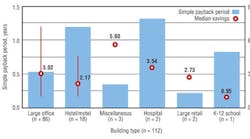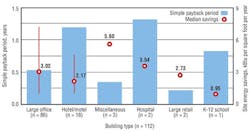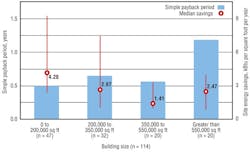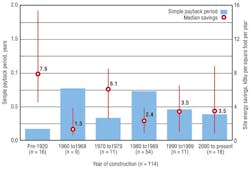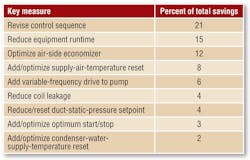Editor’s note: The figures and table used in this article are adapted from “A Study on Energy Savings and Measure Cost Effectiveness of Existing Building Commissioning”1 and used with permission from PECI Inc. and Lawrence Berkeley National Laboratory.
The Great Recession, as the last five-plus years have come to be known, has been tough on building owners and operations-and-maintenance (O&M) staffs. As they face mounting pressure to maximize net operating income, they increasingly are turning to existing-building commissioning (EBCx) to keep maintenance and utility costs down. This article will define contemporary EBCx, describe the contemporary EBCx process, and discuss associated energy and cost savings. It also will discuss a more targeted approach to EBCx for tight operation budgets.
Contemporary EBCx
Definition and typical process. There are many accepted definitions of EBCx. In this author’s opinion, the best is the Building Commissioning Association’s:
(Existing building commissioning) is a systematic process for investigating, analyzing, and optimizing the performance of building systems through the identification and implementation of low/no cost and capital intensive Facility Improvement Measures and ensuring their continued performance. The goal of EBCx is to make the building systems perform interactively to meet the Current Facility Requirements and provide the tools to support continuous improvement of system performance over time. The term EBCx is intended to be a comprehensive term defining a process that encompasses the more narrowly focused process variations such as retro-commissioning, re-commissioning, and ongoing commissioning that are commonly used in the industry.
EBCx is about improving the controllability and operability of building systems to meet the operating requirements of a facility. Except for Continuous Commissioning, which is a unique process trademarked by the Texas A&M Engineering Experiment Station, this typically involves:
1. Planning. The EBCx provider works with the building owner and manager/engineer to devise a plan to systematically identify opportunities to improve the performance of building systems to meet current facility requirements (CFR). CFR typically are documented and included in a plan providing direction to all project-team members and forming the basis for identification of facility-improvement measures (FIM).
2. Investigation. The EBCx provider performs on-site assessments of the controllability and operation of equipment and systems. The EBCx provider identifies measures that may save energy and lower operation costs. The EBCx provider also identifies maintenance items (e.g., chilled-water coils that are dirty or damaged, insulation that is peeling or has been torn away from ductwork, sensors/transducers requiring calibration) and deficiencies that, if corrected, will improve performance, but not necessarily save energy or money. The investigation findings are presented to the building owner and manager/engineer for consideration.
3. Implementation. The EBCx provider guides the selection of FIM to implement and helps to identify maintenance items that can be handled by the in-house O&M staff. The EBCx provider then develops an implementation plan. Later, the EBCx provider verifies that the FIM were implemented as specified and that the maintenance items were addressed.
4. Turnover/handoff. The EBCx provider works with the building manager/engineer to ensure a smooth transition to the building O&M staff. The overall results of the EBCx process are presented to the building owner and manager/engineer.
5. Persistence/ongoing commissioning. The EBCx provider monitors and tracks the persistence of the implemented FIM and works with the building owner and manager/engineer to implement additional FIM and address any outstanding maintenance issues.
Potential energy and cost savings. Through a well-planned and implemented EBCx program, there is good potential for energy and cost savings. EBCx has been shown to provide 16 percent median whole-building energy savings with a simple payback period of 1.1 year.2 EBCx also has been shown to provide a cost-benefit ratio of 4.5 and cash-on-cash returns of 91 percent. It should be noted that energy savings and cost-effectiveness vary based on building type, size, and age (figures 1-3).1 For example, a large office building has median energy savings of 3.02 kBtu per square foot per year with a simple payback period of approximately seven months, while a hotel has median energy savings of 2.17 kBtu per square foot per year with a simple payback period of approximately 1.4 year.
Alternative EBCx
Not all FIM are created equal. Through analysis of 122 EBCx projects and more than 950 implemented FIM, nine “key measures” were found to combine for 75 percent of project energy savings (Table 1).1The average simple payback period for the nine key measures varies from three months for “optimize air-side economizer” and “reduce equipment runtime” to 1.3 year for “revise control sequence.”
The “key-measure mix” can serve as the basis of a more targeted approach to EBCx for cost-sensitive building owners. The process is the same as that of full EBCx, but limited in terms of the measures that are investigated and implemented.
Defining the scope of work. Targeted EBCx can be a cost-effective alternative to full EBCx when the scope of work is clearly defined in request-for-proposal (RFP) documents. When writing a RFP for targeted EBCx, a building owner or manager should include:
• The key-measure mix. A list of the nine key measures in the key-measure mix forms the basis for the investigation and implementation phases of a project.
• Building type, age, and location. The type, age, and location of a building can have significant impacts on the commissioning provider’s consultant fees.
• A list of affected equipment. Mechanical drawings and equipment schedules are useful to a commissioning provider.
• The number and type of terminal units to be functionally tested. Typically, commissioning providers perform functional testing on a 10-percent sample of terminal units. Specifying this avoids confusion regarding sample size.
• The type of building automation system (BAS). Some types of BAS (e.g., pneumatic and hybrid direct-digital-control/pneumatic) have more limitations than others. Thus, some measures may not be feasible.
• An allowance for alternative measures. The commissioning provider should have the ability to suggest nine or 10 alternative measures for investigation.
• A request for case studies. Documentation of past project experience demonstrates the commissioning provider’s understanding of the EBCx process and ability to achieve desired results.
• A project timeline. A project timeline can help frame reasonable expectations.
Potential energy and cost savings. A targeted-EBCx project may produce as much as 7- to 12-percent whole-building energy savings, with a payback of one-and-a-half to four years, depending on local utility rates.1,2 Even though the potential energy and cost savings may be less and the payback period longer, a targeted-EBCx approach may be the preferred option for building owners and facility managers with tight operation budgets.
References
1) Effinger, J., Friedman, H., Morales, C., Sibley, E., & Tingey, S. (2009). A study on energy savings and measure cost effectiveness of existing building commissioning. Berkeley, CA: Lawrence Berkeley National Laboratory. Available at http://www.peci.org/sites/default/files/annex_report.pdf
2) Mills, E. (2009). Building commissioning: A golden opportunity for reducing energy costs and greenhouse gas emissions. Sacramento, CA: California Energy Commission. Available at http://cx.lbl.gov/documents/2009-assessment/LBNL-Cx-Cost-Benefit.pdf
A project manager for SSRCx, the facilities-commissioning division of engineering-design-and-facility-consulting firm Smith Seckman Reid Inc., Christopher M. Morales, LEED AP O+M, provides new-construction and existing-building commissioning, energy-auditing, and energy-analysis/modeling services to building owners.
Did you find this article useful? Send comments and suggestions to Executive Editor Scott Arnold at [email protected].









